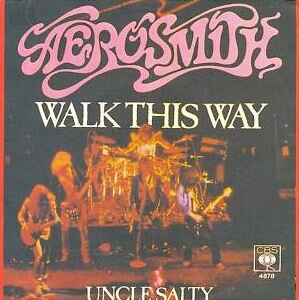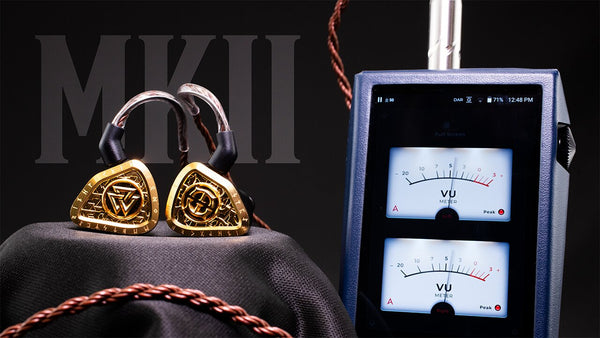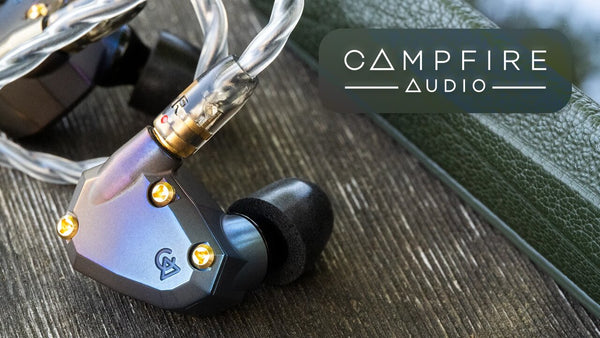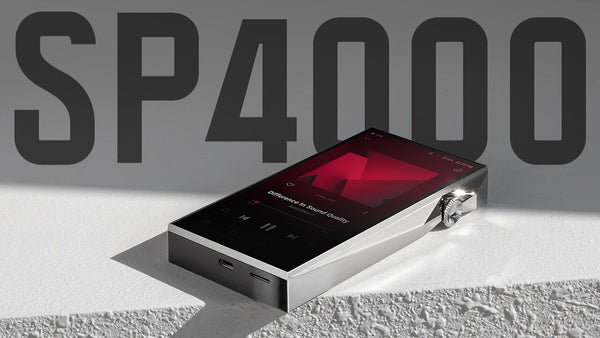Empire Ears Legend EVO IEM Review
Read Time: Approx. 16 min.

Legend EVO: An Evolution and a Revolution
If you've been following Empire Ears, you know they've done a heck of a lot during the past few years. The Georgia company is a joint venture of Jack Vang, founder of the former EarWerkz brand, and his father Dean, who has a background in hearing aid technology. Since the Vangs formed Empire Ears, the company has produced a range of in-ear monitors popular with both audiophiles and music professionals. One of those IEMs is the flagship Legend X, which is known as the "bass king" of the Empire Ears lineup. In pursuing a follow-up to the Legend X, Empire Ears set out to do something a little different. OK, a lot different: A dual conduction IEM called the Legend EVO that uses both air conduction and bone conduction.
As far as I know, the Legend EVO is the first IEM to use a full-range bone conduction driver in combination with other driver types. (There is one manufacturer that uses bone conduction technology with other driver types, but only for the mid and high frequencies.) Jack Vang has admitted that the journey wasn't easy, and that they almost gave up. At times it seemed impossible, but Empire Ears did what it always does and pushed boundaries until they succeeded.
The Legend EVO is a tribrid, eight-driver design that features five balanced armatures, two dual Weapon 9+ subwoofers, and an all-new Weapon 10 bone conduction driver. Now, I've never listened to a bone conduction headphone or IEM, but I know the basic premise, which is that they send vibrations directly to the inner ear by vibrating the bones of the skull. The Legend EVO is said to deliver a sound that is as unique as it is extraordinary. When the box landed on my desk on a recent Friday afternoon, I couldn't open it quickly enough!
Empire Ears Legend EVO IEMs Review
Empire Ears Legend X vs. Legend EVO IEMs Comparison & Review

PROS
- Bass lover's paradise
- Great energy and musicality with an excellent soundstage
- Quality Construction
CONS
- Pricey
- Larger size ear pieces
- May be too much bass for some listeners
Design
As I've found with other Empire Ears IEMs, the Legend EVO looks and feels well made. Like the Legend X, the Legend EVO sports a simple design on shiny black acrylic shells. The right faceplate features a gold Empire Ears wingspan logo, signifying Empire's never-ending pursuit of the extraordinary, while the left faceplate showcases a gold EVO logo, which Empire Ears says marks the evolution of the company's IEM technology.
The cable is an Empire X PWAudio Genesis 24 AWG ultra-pure copper cable with a 4.4 balanced Pentaconn connection. It's the best-looking Empire Ears cable I have seen, with a two-tone copper and silver braided design. Highlights include a quad connector with polypropylene reinforced core, and insulated UV-resistant polyvinyl chloride sheath.
The shells are a little bigger than the Legend X, but they don't feel unwieldy or uncomfortable in my small ears. Well, not at the outset. After a couple of hours, my ears were asking me for a break. This wasn't listening fatigue; this was the ear piece pressing on my concha. Each shell features three tiny vents that help to release energy that builds up inside of dynamic driver IEMs. The Legend EVO comes with an array of Final Audio Type E silicon ear tips. Note: You cannot use foam tips with the Legend EVO.
Sound
I'm not going to waste any time here: The Legend EVO absolutely wowed me. From the moment I started listening, I was swept away by the incredibly full and bassy sound. It was like the Legend X on steroids. I was really feeling my music—body and soul.
Starting at the bottom, there is great sub-bass energy and power. I really felt this. But as big as the bass is, I never felt like it was overpowering anything else. Low frequency instruments sound clear and defined—basslines in many tracks are so defined as to feel almost sculpted. The Legend EVO boasts some lower midrange warmth that makes vocals sound intimate and emotive. At times I perceived a subtle recessing of the vocals, but it was subtle at best. There's good mid-bass clarity. Treble is smooth but still detailed. Nothing sounds muddy or jumbled.
Queuing up one of my standard test tracks, Jethro Tull's "Skating Away on the Thin Ice of a New Day," I was pleased to hear the opening tea-making sequence present with as much crispness and clarity as on more analytical headphones. The clink of the teaspoon against the cup; Ian Anderson's humming; the tea being poured—sounded super clear and present. The song itself came at me with a lot of power, that sounded like it occupied a big space. Higher frequency sounds—flutes, bells, xylophone—did not compete with the bass, and they actually had more sparkle than I anticipated.
The Legend EVO absolutely wowed me. I was really feeling my music—body and soul.
Aerosmith's "Walk This Way" sounded thunderously deep and strong. I could really feel the bass on this track. Vocals sounded slightly set back, but I could still hear them distinctly. The guitars sounded deliciously meaty. I expected a track like this to sound great on the EVO.
What I didn't expect was for a song like Taylor Swift's "Willow" to sound the way it did. I feared that the strong bass would simply drown out the rest of this spare, somber, indie-style track. Not so. Now, there is a definite bass presence here. But Swift's voice is sweet and strong and full of emotion and nuance. The vocals actually sound more forward here than on most other tracks I listened to, but that could be the recording. Overall, the EVO captured the moody vibe of this song and amplified it quite nicely. (Side note: Whatever you think about Taylor Swift's music, throw it away and check out her two latest albums, "Folklore" and "Evermore." You may not recognize her!)
Remember that bone conduction works by vibrating the bones in your jaw and skull? Even if I had forgotten that, my experience with the Legend EVO would have reminded me. I could feel the music in my skull bones, particularly toward the back of my head. This was a unique experience. After I stopped listening, I felt a slight vibratory feeling in my head for a couple of minutes afterward.
The Legend EVO's low impedance and high sensitivity make this IEM easy to drive. I thought the EVO sounded phenomenal while streaming Qobuz on my iPhone. I also paired the EVO with the Astell&Kern KANN Alpha digital audio player and with the Matrix Audio Element X headphone amp/DAC/music streamer during my testing sessions.

Skating Away on the Thin Ice of a New Day
By Jethro Tull
(War Child)

Walk This Way
By Aerosmith
(Uncle Salty)

Willow
By Taylor Swift
(Evermore)
Features
Legend EVO Driver Technology
The Legend EVO uses dual conduction technology. The dual Weapon 9+ subwoofers and five balanced armature drivers deliver a full-range frequency response via air conduction, while imaging, soundstage, detail retrieval, low frequency extension, and reverb is greatly enhanced from 5Hz-35kHz via bone conduction from the W10. The Legend EVO employs a 9-way proprietary synX Crossover Network to unify the eight drivers.
About the Weapon 10 Bone Conduction Driver
"Unlike the competition the Legend EVO does not utilize bone conduction 'vibration' cover plates, piezoelectric ceramics, ceramic layers/coatings, voltage boosters, electrostatics, a faceplate vent, metal vents, metal bending plates, metal nozzle nor a frequency divider circuit board of any kind to transmit vibrations via bone conduction. The W10 is the most innovate, advanced bone conduction implementation in the IEM industry." - Empire Ears
The W10 is a full-range driver that is strategically ceiling mounted in a specially designed cavity at the top of the shell. This cavity is engineered to keep all sonic vibrations internal, maximizing bone conductivity transfer through the solid-filled ear canal. The W10 features a nickel-plated, SPCC chassis that is designed to eliminate any coloration that may occur from internal resonance or flex.
The W10 is strategically ceiling mounted in a specially designed cavity at the top of the shell. This cavity is engineered to keep all sonic vibrations internal, maximizing bone conductivity transfer through the solid-filled ear canal. The W10 features a nickel-plated, SPCC chassis that is designed to eliminate any coloration that may occur from internal resonance or flex.
Integral to the performance of the W10 is a highly potent N52 neodymium magnet. N52 is the highest grade of neodymium currently available. According to Empire Ears, the entirety of the W10’s design revolved around this very magnet.
The W10 uses a Japanese-made pure copper voice coil optimized for accuracy in frequency and transient response. The consistency of winding tension, density of enamel, adhesive application techniques, dimensions and copper compositions were all factors essential for linearity, ultra-low distortion and efficient heat dissipation. The voice coil is one of the most important aspects of the W10. When the electrical current of an audio signal passes through the coil it creates a varying magnetic field that pushes and pulls against the W10’s magnet. By altering the current back and forth, Empire Ears is able to generate immense levels of sonic vibrations throughout the W10’s chassis.
About the Weapon 9+ Subwoofer
The Legend EVO features two Weapon 9+ (also written Weapon IX+ and W9+) subwoofers, one dedicated to subsonic frequencies and one for the lows and mid-lows. This means that one subwoofer produces a rich and luscious tone while the other provides the air pressure of the hit. The Weapon 9 is a proprietary 9mm rare-earth magnet subwoofer with the ability to deliver extreme output, accurate dynamics and sublime sound quality all at the same time.
The original Weapon 9 subwoofer redefined what’s possible with low frequency reproduction in IEMs. The updated Weapon 9+ subwoofer boasts a larger internal coil diameter, more linear excursion envelope along with a more capable suspension to handle peak-to-peak excursion while mitigating distortion.
Empire Ears' A.R.C. Technology
A.R.C., or Anti-Resonance Compound, is Empire Ears' solution to unwanted resonant vibrations. In-shell resonance is actually one of the least mentioned causes of ear fatigue. A.R.C. is a proprietary combination of advanced polymers that dries into a coating that adds to the relative mass of each component to which it is applied, dampening the resonant vibrations.
A.R.C. effectively increases the mass of the IEM's components it's applied to: every driver, crossover, and sound tube. This gives these internal parts more solidity while serving as a dampener to absorb the unwanted resonances instead of reflecting them out of phase. The in-shell ambiance reflecting off the shell walls creates a slight echo and robs the IEM of clarity and causes frequencies to bleed out of phase. With A.R.C., clarity is increased substantially, bass is deeper, and the IEM becomes more efficient overall.
"Developing a driver from the ground up is a hellacious task, but it's what needs to be done when you want to break barriers." –Jack Vang
What is Bone Conduction?
Bone conduction technology has been used for decades, both in the development of hearing aids and by the military. Bone conduction provides a different kind of listening experience. With this method, the bone conduction device performs the job of your eardrums. Unlike traditional headphones that use air conduction, bone conduction completely bypasses the outer and middle ear components by sending vibrations directly through the skull to stimulate the hair cells inside of your cochlea in the inner ear. Bone conduction is generally perceived to have a lower, deeper tone because the skull conducts lower frequencies more efficiently than air. That being said, bone conduction headphones and earphones are not known for having the best audio quality.
Contrast this with air conduction, whereby our eardrums convert soundwaves into vibrations that travel through the eardrum to the cochlea. Sound is collected by the outer ear and directed along the ear canal into the ear drum, vibrating the bones of hearing (ossicles) in the middle ear to stimulate the hair cells inside of the cochlea in the inner ear. This stimulation creates electrical nerve impulses which are then carried to the brain by the auditory nerve to be converted into sound.
Bone Conduction:
- No outer or middle ear involvement
- Vibrations bypass the eardrum and go directly to the cochlea (inner ear)
- The bones of the skull vibrate and stimulate the cochlea
- Essentially, you're listening with your bones instead of your ears
Air Conduction:
- Involves outer, middle and inner ear
- The eardrum converts sound waves to vibrations and transmits them to the cochlea
- Vibrations travel through the eardrum to the cochlea (inner ear)
- The eardrums vibrate
As Empire Ears explains: "Your voice is a primary example of a bone conduction system that’s already in place. When you hear your voice, it’s a combination of both air and bone conduction. But because the sound of your voice originates from your head the dominant signal transmitted is through the bone, leading to a deeper tone. You’ll notice that when you listen to your own voice via playback the tone will be higher pitched as the bone conduction signal is no longer prevalent. You can also experience this phenomenon by simply plugging your ears and speaking as the vibrations will be passed through the skull to be perceived by your cochlea."
A benefit of bone conduction listening devices is that they allow ambient noise in, so they're good for situational awareness while you engage in outdoor activities. Also, because the eardrum isn't involved, they're ideal for people with hearing loss due to damage in the outer or middle ear. But Empire Ears had another reason for wanting to incorporate bone conduction technology into the Legend EVO. Through bone conduction, humans can perceive ultrasonic frequencies (beyond 20kHz). Now, humans can detect ultrasound up to at least 100kHz, but perception generally requires direct contact of the source with the body. In the Legend EVO, a full range 5Hz-20kHz frequency response is delivered via air conduction from the dual W9+ subwoofers and 5 balanced armatures, while imaging, soundstage, detail retrieval, low frequency extension, and reverb is extraordinarily enhanced from 5Hz-40kHz via bone conduction from the W10. The result is that you sense more air and energy in your music. The sound becomes livelier.
Comparison to the Legend X
Naturally you're wondering how the Legend EVO compares to its predecessor, the Legend X. First and foremost, if the Legend X is the "bass king" at Empire Ears, then the Legend EVO is the supreme bass ruler of the universe. That Weapon 10 bone conduction driver really digs down to deliver the lowest of the low, the deepest of the deep-sounding bass. But it's not just a sound; it's a feeling. The Legend X is no slouch when it comes to bass, but the Legend EVO gives you bass that you feel in your head, body, and soul. It comes up from the ground and it falls down from above. It's everywhere! In this respect, the Legend EVO conveys a sense of power above and beyond the Legend X. Basslines on both IEMs are quote perceptible, but perhaps a little more defined, a little tighter on the Legend EVO
On both the Legend EVO and Legend X, I perceive a slight midrange dip. It's subtle, and I don't hear it on every track, but I would say this dip is greater on the Legend X. (The Legend X Special Edition, which I have not listened to, touts slightly more present mids). On both IEMs, I would categorize the highs as smooth, but I feel like they have a little more "zing" on the Legend EVO. For example, flute sounds a touch livelier and sweeter on the EVO.
They're both phenomenal IEMs. If you have the Legend X and are wondering if you should spring for the EVO, I would say yes if you have the funds. However, if you've going straight for the EVO, I see no reason why you'd need the Legend X too. That being said, the Legend EVO is currently only available as a universal IEM. If you're looking for a custom IEM, then the Legend X will be your option.
Legend EVO:
- Dual Weapon 9+ subwoofers
- 5 balanced armature drivers
- 1 Weapon X bone conduction driver
- 9-way synX Crossover Network
- Frequency response: 5Hz-35kHz
- Impedance: 4.5 Ohms
- Sensitivity: 103dB
Legend X:
- Dual Weapon 9 subwoofers
- 5 balanced armature drivers
- 10-way synX Crossover Network
- Frequency response: 5Hz-40kHz
- Impedance: 14 Ohms
- Sensitivity: 102dB
Dragon Cables
I opted to pair the Legend EVO with a Silver Dragon IEM Cable. Because the EVO has such prominent bass, I decided to focus on the upper frequencies. The Silver Dragon is known for being a detail lover's cable. UP-OCC silver strands are adept at finding "lost" middle and high frequencies, which can get "forgotten" in a bass-heavy headphone or IEM. The Silver Dragon also enhances instrument separation so you can really discern all there is to hear. The Silver Dragon's detailed signature is a great way to tighten up the bass and the low-mids, offer more mid-range, and allow the highs to be clearer and more pronounced.
But there are no hard and fast rules when it comes to cable pairings. Click here to learn more about our Dragon Cable options.
Verdict
Wow. I had high hopes for the Legend EVO, and now I have high praise. It's got a huge, powerful sound, with masterful and copious low end that will please even the most die-hard bass fanatic. The thing that makes the Legend EVO stand out from other IEMs, including its predecessor Legend X, is the visceral quality of the sound, and the way you experience it both inside and outside of your body. But the EVO has a big soundstage that allows all instruments to claim their space rather than being drowned out by the bass.
The Legend EVO demonstrates prowess with genres like rock, rap, R&B and EDM, but it also works well with genres like classical or jazz that benefit from a big soundstage — anything with a big, bold presentation. It comes down to personal preference: If you like this type of sound signature, you're probably going to enjoy it with much of your music. Like to watch movies on your laptop? Listen with the Legend EVO for a sound experience that will have you immersed in the action. At $3,099, the Legend EVO costs $800 more than the Legend X. Hi-fi enthusiasts who love a big bass response and are looking for a flagship-quality IEM with a "wow" factor will love the Legend EVO.
Featured Products
Related Videos
Empire Ears Legend EVO IEMs Review
Empire Ears Legend X IEMs Review
Empire Ears Legend X vs. Legend EVO IEMs Comparison & Review
What's in the Box
Specifications
Dual Conduction Architecture
W10 bone conduction ultra driver
Dual W9+ Subwoofers
Five Precision Balanced Armatures
Weapon X Bone Conduction Ultra Driver
9-Way synX Crossover Network
ARC Resonance Mitigation Technology
Impedance: 4.5 Ohms @ 1kHz
Frequency Response: 5Hz-40kHz
Sensitivity: 103dB @ 1kHz, 1mW
Cable: Empire X PWAudio "GENESIS" Ultra Pure OCC Copper Cable, 4.4 Pentaconn Termination




























